When we talk about building wealth, we usually think in terms of how much we earn, save, or invest. But there’s a quieter, often overlooked factor that plays a significant role in whether our wealth grows or stagnates: opportunity cost. It doesn’t come with alarms or red flags, but over time, it can quietly erode your financial potential. So, what exactly is opportunity cost, and why should every smart investor—and everyday saver—care deeply about it?
Che cos'è davvero il costo d'opportunità?
Opportunity cost refers to the potential benefits you miss out on when choosing one alternative over another. It’s not just a theoretical concept taught in economics textbooks—it plays out every time you decide how to spend, save, or invest your money. For instance, if you leave € 5,000 in a checking account earning 0% interest instead of investing it in a diversified index fund yielding an average of 7% annually, your opportunity cost after 10 years could exceed € 4,000 in forgone growth.
And this isn’t just about investing. Opportunity cost applies when you choose to buy a new gadget instead of contributing to your emergency fund, or when you delay starting your investment journey because “the market feels uncertain.” In every financial choice, there’s a hidden cost to inaction or suboptimal decisions.
L'impatto sul mondo reale: Piccole decisioni, grandi differenze
Let’s take a closer look with a practical example. Imagine two individuals: Luca and Sara. Luca decides to invest €200 per month starting at age 25, while Sara starts at age 35. Assuming both earn a 7% annual return and invest until they’re 65, here’s what happens:
- Luca avrà accumulato circa € 520,000
- Sara si ritroverà con circa € 245,000
Questo ritardo di 10 anni è costato a Sara quasi € 275,000. That’s the opportunity cost of waiting.
Similarly, keeping € 10,000 in a savings account that yields 0.5% interest instead of placing it in a high-yield bond or equity ETF with a 6–7% return costs thousands over a decade. In today’s inflationary environment—where prices rise and cash loses value—the opportunity cost is even steeper.
Why It’s Hard to Notice (and Even Harder to Act On)
Opportunity cost is subtle because it’s invisible. You never get a notification saying, “Hey, you just missed out on € 3,000 in gains by not investing!” That makes it psychologically difficult to appreciate. Behavioral finance research has shown that people tend to prioritize immediate outcomes over long-term gains—a phenomenon known as “present bias.” That’s why buying the new phone feels better than contributing to your retirement account.
What’s worse, the fear of loss often outweighs the potential for gain. People might keep money in cash because they fear market volatility, even if long-term data shows consistent market growth. According to historical data, the S&P 500 has returned an average of 10% per year over the past 50 years (before inflation). Letting that kind of return slip away year after year is a massive cost—just one that doesn’t show up on a statement.
Come essere più intelligenti con il costo d'opportunità
La buona notizia? Una volta compreso, è possibile utilizzare il costo opportunità a proprio vantaggio. Ecco alcuni cambiamenti pratici di mentalità:
- Before every major financial decision, ask: “What am I giving up by choosing this?”
- Considerate la liquidità inattiva come una risorsa che potrebbe lavorare per voi.
- Prioritize early investing—even small amounts. Compound interest is your best ally.
- Don’t delay decisions that benefit from time, like retirement saving or ETF investing.
- Educate yourself on alternatives. Often, the most comfortable option (like holding cash) isn’t the best.
La ricchezza che non avete mai visto (ma che potreste ancora creare)
Opportunity cost is invisible—but powerful. Every euro not invested, every year you delay action, and every fear-driven decision you make has a financial echo. But awareness changes everything. Once you start viewing money not just in terms of what it is, but what it could become, you begin making decisions from a place of clarity and control.
And remember, you don’t need to be perfect—you just need to be intentional. Building wealth isn’t always about radical changes; it’s often about reclaiming the quiet losses you never noticed. Because in the end, the biggest wealth killer might not be the market—it might be standing still.

